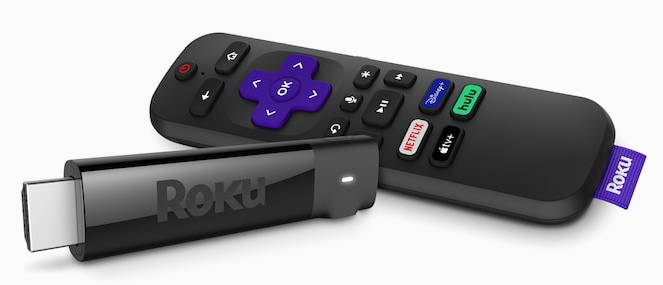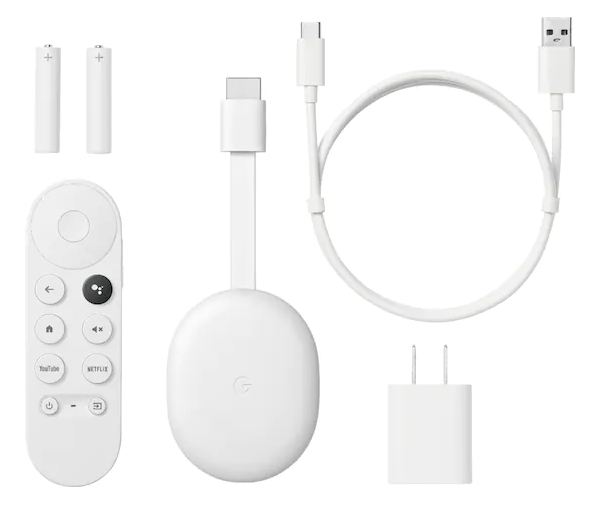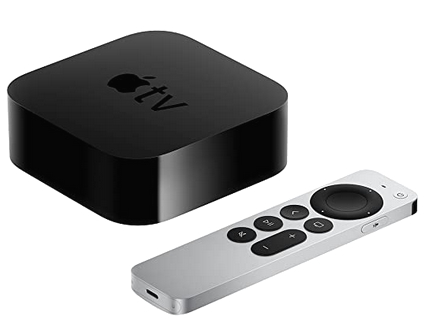
 |
|
Internet Streaming Media Player Boxes, Players, Sticks Comparison - Internet TV What is streaming? Media content delivered to computers, TV and mobile devices via the internet in real time in a continuous flow. Podcasts, webcasts, movies, TV shows and music videos are common forms of streaming content. The market today: ROKU, Amazon, Google and Apple dominate the majority of devices available for TV streaming. Connection to TV: HDMI (some older devices had composite video). Required: Internet service - Wi-Fi Notes: Content can be free but many providers require an account and charge for content. • See the Players - ROKU : AMAZON : GOOGLE : APPLE Your TV needs a source of content for you to watch anything. Local TV over-the-air broadcasts came first in the 1940s, with just a few choices, CBS, NBC, ABC, PBS. Then cable TV in the 1980s with more channels using a coaxial cable into your home, and then satellite TV, plus we had movies on VHS tapes in the 1980s and 1990s. Then DVD arrived in the late 1990s using an optical disc to store video and audio. Netflix mailed out your DVD movie which was nice but still not the best solution. You had to mail your DVD back to Netflix. The Internet arrived in 1995 but only after the turn of the new century did the internet allow new providers such as Netflix, to stream movies and video content directly to your home. More advantages of internet streaming media: When you viewed broadcast, cable or satellite TV, it was always on the TV network's schedule, not your own schedule. The VCR changed that with timed recordings. The DVR also allows the same "watch when you prefer", schedule. What if you want your movie right away, without leaving home or waiting for the mail to arrive? What if you want other information or entertainment right away, no waiting required? Today we have moved to the internet to gain instant access to whatever information or entertainment we want. What you have to do is get the internet content on your TV for a big-screen experience. One of the best things about streaming internet movies or other video content is the ability to choose what you want to watch and when, as well as to pause, fast-forward or rewind that content. But beware of the hoops you will have to jump thru to get setup and the inconsistencies of the technologies. Getting internet content usually means paying for internet service, unless you can access free wi-fi service at home where the big-screen TV resides, but this still requires a computer. What if you are not computer savvy? Well, today it seems there is a solution for almost everything. Enter the streaming internet media box or player. Known by other names such as IPTV or media streamers or network media players or internet TV players, these small boxes or sticks connect to your TV and the internet thru your internet service provider and your home network (router and modem) to bring you movies and music, sports, news and other TV entertainment. Some see these boxes as the future of TV viewing and have dropped their cable TV service in favor of a more custom tailored viewing experience. TERMS - 8K : The next advancement in video resolution after 4K. TV displays are available now. Content will be widely available soon. 4K Ultra High Definition: While no longer the highest resolution available (8K), 4K UHD is the highest resolution with significant support from content creators and distributors. At around four times that of 1080p HD (4K is 3840 x 2160), 4K is the current standard for all but the most expensive new TVs. 802.11ac Wi-Fi: Superseded by Wi-Fi 6, 802.11ac is still fast — fast enough even for streaming 4K HDR content — but it's not as fast as Ethernet. Android TV: An app-centric smart TV platform powered by Google's Android software and available across smart TVs, set-top boxes, and more. Google TV: A personalized smart TV interface that runs on top of the Android TV software. Casting: A term popularized by Google for making content found on a mobile device or PC appear on a TV or wireless speaker. High dynamic range (HDR): Short for high dynamic range, HDR offers better contrast, better brightness, and more colors. It's considered by many to be a more notable visual improvement than the jump from 1080p Full HD to 4K Ultra HD resolution. HDR10: The most widely adopted HDR format. Dolby Vision: A dynamic HDR format (as opposed to the static HDR10), Dolby Vision has several advantages, such as the ability to gauge your HDR TV's capabilities and tailor the HDR experience. HDR10+: A license and royalty-free dynamic HDR format that competes with Dolby Vision. It initially showed up on Samsung TVs (which do not offer Dolby Vision), however, it is now gaining traction among other TV makers like TCL and Vizio. So far, only a handful of streaming video services, like Amazon Prime Video, support HDR10+. Dolby Atmos: A technology that allows sound designers to specify the positioning of audio in an immersive, 3D soundstage. Sounds can be placed anywhere around a room, bringing you deep inside the action on-screen. Dolby Atmos sound systems can include multi-thousand-dollar setups with installed ceiling speakers, but can also be had in a $200 soundbar that creates a virtual Atmos experience from as few as two channels. Support for this sound format varies from device to device, and not all streaming services offer Dolby Atmos content. Those that do, don't offer it on all of their TV shows and movies. In 2009 we saw the HDTV market adding internet capability to select TVs. The content was limited to just a few sites and no browser. In 2010 we saw several innovators offering a way to get internet content on a TV without connecting via a computer (desktop or laptop). In 2011 there has been a refinement of these new internet media player boxes. Some are in their second, third or fourth generation with wireless 802.11n, onboard storage, HDMI and better user interfaces. So what internet media players are available and which boxes are best? Every year or so a new device is released with more features and upgraded performance so the newest devices will have faster speeds, better resolution and control. There are usually basic devices and then high end devices with prices to match. Remember you need high-speed internet service to use these boxes/sticks and also a router (wired/wireless) and modem at home. The media box interfaces/connects to your router (wired or wireless) and then to the TV. Note: Requires High-Speed Internet Service Broadband speed of at least 2.5 Mbps recommended (10 Mbps or more for HD video). Content may require fees. Wireless connectivity requires an 802.11 home network LAN (802.11n at least recommended).
Diagram - Internet streaming media player to home network and TV ROKU: over 8 devices are offered. Roku Express, Express 4K, Express 4K+, Streaming Stick, Streaming Stick 4K, Streaming Stick 4K+, Ultra, Ultra LT, Stream Bar. Cost: $30 to $180 
ROKU is the leader in streaming and has been for years. Most choices in hardware and the number of apps. Less annoying advertising than Amazon. Most people prefer ROKU over Amazon TV Stick. Amazon tends to push their own products where ROKU is more non-aligned. Voice control and earphone capability are on the ROKU remote. • How to setup ROKU Streaming Stick Q: Why do I need to setup a ROKU Account? A: Before you can start streaming media content over the internet, channels (apps) must be downloaded and installed on your Roku® streaming player. To accomplish this, your Roku device must first be linked to a Roku account. With a Roku account, not only can you add channels from the Roku Channel Store, but you can also manage your subscriptions and linked devices, view your purchase history, and update preferences such as your PIN and payment method (credit card). Note: There is NEVER a charge to create a Roku account. When creating a Roku account, it’s important to have a valid email address in order to manage your account and to receive important account notifications. Similarly, you should choose a strong, secure password. Q: Do I have to pay an activation fee? A: No. Roku players do not require an activation fee, registration fee, equipment rental fee, service fee, or any charge for support of any kind. Q: Will Roku Streaming Stick 4K+ work with Siri, Alexa, or Hey Google? A: Yes, Roku Streaming Stick 4K+ works with all of these popular voice assistants. Q: Can I watch anything FREE on ROKU? A: YES, you can watch many FREE Classic TV shows, movies and more. Q: Where can I get information if I have questions? A: Go to ROKU.com and then SUPPORT. • ROKU Streaming Players Amazon: over 5 devices are offered. Fire TV stick LITE ($30), Fire TV stick, Fire TV stick 4K ($40), Fire TV stick 4K Max ($50), Fire TV Cube ($120). Cost: $30 to $120 Fire TV stick 4K Max - 40% more powerful than Fire TV Stick 4K, with faster app starts. Support for next-gen Wi-Fi 6 - Enjoy smoother 4K streaming across multiple Wi-Fi 6 devices. Cinematic experience - Watch in vibrant 4K Ultra HD with support for Dolby Vision, HDR, HDR10+ and immersive Dolby Atmos audio. Stream more than 1 million movies and TV episodes. Watch favorites from Netflix, Prime Video, Disney+, Peacock, and more, plus listen to millions of songs. Subscription fees may apply. Live and free TV - Watch live TV, news, and sports with subscriptions to SLING TV, YouTube TV, and others. Stream for free with IMDb TV, Pluto TV, Tubi, and more. Alexa Voice Remote - Search and launch content with your voice. Get to favorite apps quickly with preset buttons. Control power and volume with one remote. 
Amazon Fire TV streaming is of course geared for Amazon video service. Google: Chromecast with Google TV - 4K ($50) voice remote  Google only offers one media streamer, the $49.99 Chromecast With Google TV. This is a nice step up from previous Chromecast devices, adding 4K streaming, a remote, and an on-screen interface to the experience. Video support: 4k/60 Hz, 1080p, Dolby Vision, HDR10, HDR10+ Audio support: Dolby Digital, Dolby Digital Plus, Dolby Atmos Connections: Wi-Fi 5 (802.11ac), HDMI 2.1 (built-in), USB-C (power/Ethernet) Remote control: Remote control with voice control, Android & iOS app Voice search is above average but only for current shows. For those already living in the Google universe, this device is best. Disney+, ESPN+, HBO Max, Hulu, Netflix, Prime Video, STARZ, Sling TV, Spotify, YouTube, YouTube TV. Screen mirroring, bluetooth, Google assistant. Not compatible with some Audio/Video Receivers. Hardware not as robust as ROKU. Google Assistant is a robust voice assistant for media streamers. It's easily as powerful as Amazon Alexa, offering the same content search, smart home control, and general information functions, but it's much more flexible with language. Apple: Apple TV 4K. Cost: $129 : $149 Apple TV has most apps, but TV boxes remain a side project for Apple. It doesn't update its models or its interface all that often. Apple cares more about its Apple TV+ subscription service than its physical hardware. But if you live in the Apple universe, enjoy AirPlay, iPhone, iTunes etc. this device will complete your collection.  • 4K Dolby Vision and HDR10+ • Dolby Atmos for three-dimensional, theater-like sound • A15 Bionic chip • The latest shows, movies, sports, and live TV from your favorite streaming apps • Use FaceTime to connect with family and friends on the biggest screen in your home • Siri Remote brings precise control with a touch-enabled clickpad • Use AirPlay to share photos, videos, and more from your iPhone, iPad, and Mac on your TV • Listen without disturbing others by connecting up to two sets of AirPods using Spatial Audio • Pair with HomePod speakers for an immersive, cinematic home theater system • Acts as a home hub to easily and securely control smart home accessories while away from home. • Wi-Fi and Ethernet for high-speed data transfer If you do not have an HDTV, don't worry. Some streaming media players do have the capability to connect to older analog TV sets. Using an RF modulator, you can even connect a TV set with only an RF coaxial input. There are always converters, adapters and connectors to hookup a TV. • Apple TV 4K Wi‑Fi + Ethernet • Make any TV into a Smart TV Conclusion: To get you started, the Roku Express or the Amazon Fire TV Stick Lite, would be the least expensive way to dip your toe into the water. However they are not fully featured and for anyone with a big screen TV, they will want to step up to the mid-range devices. Roku is simpler in terms of user interface, fans of Google Assistant will be drawn to the Chromecast with Google TV, while fans of Alexa will find the Fire TV Stick familiar. Those living in the Apple ecosystem will find that the Apple TV models offer access to features that none of the others offer - but it will cost you more. The Fire TV Stick 4K Max offers a great experience. Chromecast with Google TV is close in experience and Roku Streaming Stick 4K also delivers the goods. Try one, you can always go a different route after learning the landscape. Many companies are offering internet media boxes, so a complete list would be almost impossible. Each company offers a different box but there are many similarities. Apple, Google Chromecast, Amazon Fire TV, ROKU, are some of the brand names of these internet media players. Most allow you to get Netflix movies and connect wirelessly to your router and to your HDTV with an HDMI cable. Some will allow connection to an older TV set with analog composite video cables. Most have a surround sound optical output port to allow external loudspeakers. The internet sites offered on the players for movies and TV are Netflix, Vudu, Hulu plus, Amazon video, Blockbuster, YouTube and for music, Pandora, iTunes and more. Each box has limitations on content or connections so check out the specifications carefully. For example, if you have only an older tube CRT TV, then the Apple TV box is not for you because it only has an HDMI connection for the newer HDTVs. Only a laptop or desktop PC will be able to access ANY internet site. Connecting the computer to the TV can be done also. See laptop to TV for more information. Streaming Media Providers: There are thousands of sources or channels on the web, some content is free while others require small rental costs or monthly fees. Some of the major providers are: Netflix - streaming only plans start at $7.99 per month. Netflix recommends that people stream its movies over a broadband connection with a speed of at least 1.5 megabits per second (1.5 Mbit/s), and that people use an Internet connection of at least 3 megabits per second to get better-looking video on par with a DVD. How many movies does Netflix offer? More than you could ever view. Vudu - Now owned by Wal-Mart, Vudu has announced 3D-HDTV streaming content. Most movies are $4.99 for an HD rental for 24 hours. More than 17,000 movies and TV shows. If you have a fast Internet connection (and a Wireless-N router), Vudu is a great way to enjoy high quality new releases at home. Hulu plus - $7.99 a month. There is some overlap between the content offered by Hulu Plus and Netflix, but Hulu wins for current episodes of hit TV shows. Amazon video - Movies and TV shows are available for purchase or rental a la carte. TV episodes are sold for $1.99 each and select shows can also be rented for $1.39 an episode. New release films are $3.99 for a rental and usually $14.99 to own. Over 200,000 TV episodes and movies, millions of songs, and hundreds of games. Internet Streaming Media players:
All internet media players are NOT created equal. Check carefully before you buy to ensure the player will be able to process the video and audio files you intend to use. Some players will process .MOV files, MPEG/MPG, AVCHD, FLV/F4V, VC1, xVID, DIVx video and some will not. The same applies to audio files. AAC, MP3, WMA, WAV, LPCM, OGG, the player may not be able to process all files. The Western Digital TV live HUB can process the most file types but you may only use a few file types. The Streaming Media Players:1. ROKU - The ROKU is at the top of the list of streaming media players.2. ROKU - Roku streaming HDMI stick. 3. APPLE - The Apple TV box will work best for Apple users. iPhone, iPad, Mac, iTunes invested people. 4. Amazon Fire TV stick - best for Amazon content. 5. Amazon Fire TV - 6. Google Chromecast - HDMI stick. Must use Google browser on latest computer. • Surround Sound over HDMI • How to hookup surround sound • Surround Sound Glossary • How to add great sound to HDTV - Sound Bar • home theater receiver • home theater in-a-box • Cable Guide How to setup wireless internet at home How to setup wireless USB adapter for a Desktop PC ROKU player setup and info Roku Support Services: 855-355-3898Available: 24 hours a day, 7 days a week
See
laptop to tv |